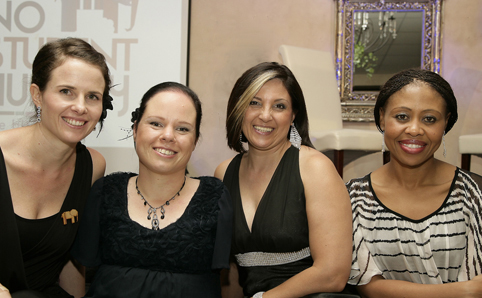 |
|
From the left is Dr. Carin Buys (Patron of NSH), Ms. Nicky Abdinor (guest speaker), Mrs. Grace Jansen (patron of NSH) and Redi Tlhabi (master of ceremonies).
Photo: Johan Roux
28 March 2012
|
Video clip (YouTube)
The University of the Free State (UFS) received over R200 000 for its No Student Hungry (NSH) Programme at the NSH launch dinner on Friday 23 March 2012 in Bloemfontein.
Prof. Jonathan Jansen, Vice-Chancellor and Rector of the UFS as well as founder of the NSH Programme donated R100 000 from the proceeds of his book We Need to Talk to this programme. Standard Bank also donated R30 000.
An additional amount of about R90 000 was raised by means of pledges made by guests and the auctioning of several items. These items were donated by local companies and university staff.
The No Student Hungry Programme (NSH) aims to raise funds to provide modest food bursaries for needy students and give them daily access to a balanced meal.
Prof. Jansen started the NSH programme in 2011 with the proceeds of his book, We Need to Talk.
The NSH funds more than 100 students in the hope of helping them to excel in their academic endeavours and, ultimately, to obtain their degrees.
In 2011, Prof. Jansen discovered that a significant number of students were studying without eating on a regular basis. These were often students with strong academic records but without adequate funding to sustain themselves with regular meals.
The project was established in January 2011 when the NSH Team started to develop the structure and processes of the programme. The first 100 students who were awarded the food bursaries started using their student cards for daily meals on campus on 1 April 2011.
“The No Student Hungry Campaign is not only about creating a university campus that cares. It is about creating a country where being human matters. Our students on the NSH project are amazing young people. They struggle to get by, but they have great potential and achieve good marks," Prof. Jansen said on Friday.
Prof. Jansen’s wife, Grace, and Dr Carin Buys, wife of Mr Rudi Buys, Dean of Student Affairs, volunteered to drive the programme and raise funds to address the problem. They are supported by various divisions within the university.
Students apply for the bursaries and are selected on the basis of their financial needs, good academic results, active participation in student life programmes and commitment to give something back to the community.
The raising of funds is a continuous process involving awareness campaigns, seeking of partnerships with companies and institutions and support from the general public, staff and individuals.
An agreement has been made with several food outlets/restaurants on campus who offer healthy, balanced meals to NSH students when they swipe their student cards that are funded by the programme.
At the end of the year the process is reviewed and students who still qualify are reinstated on the programme, whilst those whose circumstances have changed or are no longer in need of the bursaries, make way for new applications.
The NSH Team meets with students on a regular basis with the purpose of offering training, motivation and opportunities for personal growth and career development. Students are also expected to become involved in projects as a way of ploughing back into the community.
The goal is to expand the project annually as support for it grows.
Ms Nicky Abdinor, a clinical psychologist from Cape Town, who was born without arms and with shortened legs, provided an entertaining motivational speech at the launch. Ms Abdinor, founder of the Nicky's Drive organisation, also visited the UFS’ Unit for Students with disabilities where she delivered a talk on independence for people living with disabilities.
To become involved with the NSH Programme, please contact Mrs René Pelser on +27(0)51 4019087 or e-mail pelserr@ufs.ac.za.
Media Release
28 March 2012
Issued by: Lacea Loader
Director: Strategic Communication
Tel: +27(0)51 401 2584
Cell: +27(0)83 645 2454
E-mail: news@ufs.ac.za